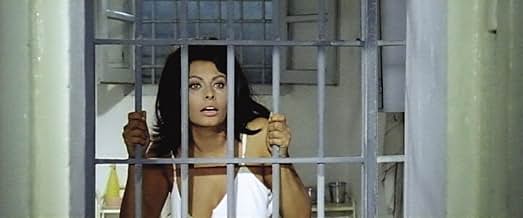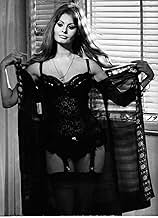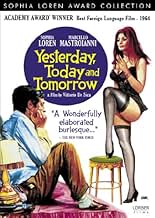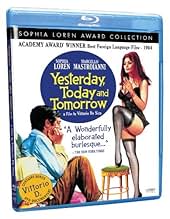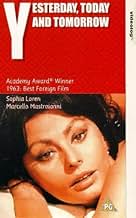VALUTAZIONE IMDb
7,2/10
10.891
LA TUA VALUTAZIONE
Storie di tre donne molto diverse e gli uomini che attraggono.Storie di tre donne molto diverse e gli uomini che attraggono.Storie di tre donne molto diverse e gli uomini che attraggono.
- Regia
- Sceneggiatura
- Star
- Vincitore di 1 Oscar
- 8 vittorie e 3 candidature totali
Tonino Cianci
- (segment "Adelina")
- (as Antonio Cianci)
Gianni Ridolfi
- Umberto (segment "Mara")
- (as Giovanni Ridolfi)
Recensioni in evidenza
Two great performers of the Italian screen, Marcello Mastroianni and Sophia Loren, star in this earthy three-episode film, directed by Vittorio De Sica and tailor-made for the two stars. The success of this film led to the making of MARRIAGE, Italian STYLE a year later. In the first of the three comic vignettes Sophia is a black marketeer in Naples who discovers that a pregnant woman cannot be put in jail and so tries to maintain perpetual pregnancy. Poor fatigued husband Mastroianni is barely up to the task, however, and this fact provides much of the humor. The middle episode, the least effective, has Loren as a Milanese rich-bitch of liberal attitudes but who likes to plow into other people's cars. In the last episode Sophia is a Roman prostitute, Mastroianni is her sex-crazed customer. Part of the story is about how she unwittingly almost destroys the vocation of a seminarian living in an apartment across the terrace. Seminarians, surrender!
Addendum: in 2005 a new DVD release in letterbox format allows us to see the movie in its original wide-screen CinemaScope ratio. It has the original Italian language version with an English-tract option and a subtitle option.
Addendum: in 2005 a new DVD release in letterbox format allows us to see the movie in its original wide-screen CinemaScope ratio. It has the original Italian language version with an English-tract option and a subtitle option.
This very enjoyable film may be a let down for someone expecting the heights of De Sica's Neorealist masterpieces like The Bicycle Thief or Two Women. However it is very funny in parts and is pointedly critical of Italian society in the boom years of the 1960s. Also Sophia Loren and Marcello Mastroianni are absolutely stunning to watch.
For people interested in Italy it is a fascinating commentary on the country that can border on stereotype. Naples (De Sica's hometown) is warm and happy and filled with clever types ready to outwit the system and find their own way to happiness. Milan is cold, rich, and callous. Rome is dominated by the Catholic church and the State with plenty of hypocrisy and corruption. But De Sica finds some humor in all of this.
I found it a little too sentimental but well worth watching. I wish a better (undubbed) print were available. De Sica's career was given a boost by the success of the movie and he would continue to make more great films like The Garden of the Finzi-Contini's and the underrated A Brief Vacation that focus on the injustices of the State and the hardships faced by working people.
For people interested in Italy it is a fascinating commentary on the country that can border on stereotype. Naples (De Sica's hometown) is warm and happy and filled with clever types ready to outwit the system and find their own way to happiness. Milan is cold, rich, and callous. Rome is dominated by the Catholic church and the State with plenty of hypocrisy and corruption. But De Sica finds some humor in all of this.
I found it a little too sentimental but well worth watching. I wish a better (undubbed) print were available. De Sica's career was given a boost by the success of the movie and he would continue to make more great films like The Garden of the Finzi-Contini's and the underrated A Brief Vacation that focus on the injustices of the State and the hardships faced by working people.
There is such a delightful playfulness to this trio of tales about relationships between men and women in Italy. Sophia Loren is in three different roles – a poor mother in Naples who keeps getting pregnant and having children to postpone being jailed for failing to pay debts on her furniture, a rich woman in Naples who has had a one-night stand while her husband is away at a conference and has picked him up the following day in her Rolls-Royce, and a high-class courtesan who does business out of her apartment overlooking Piazza Navone in Rome, attracting the attention of a young man studying to be a priest. I wouldn't say Loren has exceptional range, but she does turn in a solid performance, and plays feisty, haughty, seductive, angry, and bemused pretty well, all while being quite entertaining. Marcello Mastroianni is her counterpart in each tale (one of the clients in the last, not the young man), and is similarly engaging. It was nice to see him so light on his feet as he moved around in that last tale; his expressions were over-the-top (in a good way), and it was funny to see him ask Loren to dress up as a schoolgirl, and then watch her reaction.
The movie feels quintessentially Italian, as the characters are animated and highly expressive. There is also a feeling of genuine humanity and community. There is an honesty here, as each of the stories quite openly acknowledges sexual urges in both men and women as being natural and a positive thing, which is quite refreshing. At the same time, it remains decent and acknowledges a sense of higher morality. In the first tale, Loren's character is tempted but does not sleep with her brother-in-law when her husband can't get her pregnant again, accepts going to jail, and talks to the prisoners there without an ounce of judgment about why they're there. In the second, Mastroianni's character realizes how shallow Loren's is when she's more concerned about damage to her car after they nearly run over a child. In the third, Loren's character realizes that despite an antagonistic relationship with the young man's grandmother (played fantastically by Tina Pica), she has common ground with her, and must persuade the boy to stay on his path. How nice it is that director Vittorio De Sica shows us that these things – lust and morality – can exist side by side, perfectly well.
The movie feels quintessentially Italian, as the characters are animated and highly expressive. There is also a feeling of genuine humanity and community. There is an honesty here, as each of the stories quite openly acknowledges sexual urges in both men and women as being natural and a positive thing, which is quite refreshing. At the same time, it remains decent and acknowledges a sense of higher morality. In the first tale, Loren's character is tempted but does not sleep with her brother-in-law when her husband can't get her pregnant again, accepts going to jail, and talks to the prisoners there without an ounce of judgment about why they're there. In the second, Mastroianni's character realizes how shallow Loren's is when she's more concerned about damage to her car after they nearly run over a child. In the third, Loren's character realizes that despite an antagonistic relationship with the young man's grandmother (played fantastically by Tina Pica), she has common ground with her, and must persuade the boy to stay on his path. How nice it is that director Vittorio De Sica shows us that these things – lust and morality – can exist side by side, perfectly well.
1963's "Yesterday, Today and Tomorrow" was, like the previous year's "Boccaccio 70," another anthology feature, this time featuring Sophia Loren with her most frequent leading man, Marcello Mastroianni, starring in all three stories for director Vittorio De Sica. In "Adelina" they are a married couple living in a poverty stricken section of Naples, where she must dodge arrest for nonpayment on furniture by way of pregnancy; "Anna" finds her a bored socialite wed to an often absent industrialist who ultimately chooses wealth over love to Mastroianni's disappointment; and in "Mara" she plays a high priced call girl who vows to spend a week without sex to convince the young man next door to follow the call of the priesthood. Her final reel striptease remains the stuff of legend but is quite tame today, the actress considering it a most pleasing, natural performance. As a 1963 Oscar winner as Best Foreign Film it was a huge success, with both stars reuniting with De Sica for their next picture, "Marriage Italian Style."
"Yesterday, Today and Tomorrow" was just the kind of crowd-pleasing, feel-good foreign film that appealed to American audiences and the Academy in 1964. It won the Oscar for Best Foreign Film, the second De Sica film to win in that category after "Bicycle Thieves". Of course, this isn't in the same class as that neo-realist masterpiece. It comprised of three short stories, each starring Sophia Loren and Marcello Mastroianni. In the first she is the wife who avoids prison by getting pregnant; in the second she is a rich socialite having an affair with Mastroianni's writer, that is until he crashes her Rolls while in the third she's a Roman prostitute forced into taking a vow of chastity for a week but not beyond doing the striptease that earned the film its reputation for 'sauciness' and each story is named after the character played by Loren. It's all very jolly, sunny and likable but it's hardly Oscar material. Sophia, however, is splendid throughout.
Lo sapevi?
- QuizThe red car that picks up Mara after the accident is an extremely rare 1960 Ferrari 250 GT California Spyder SWB. Only 56 of these cars were made and some have sold for over $10M at auction in the 2010's.
- BlooperAs Anna and Renzo talk while driving, the windshield of her Rolls-Royce Silver Cloud II shakes because the little side windows are gone, but the little side windows are intact in the wide shots.
- Citazioni
Carmine Sbaratti: The people of Forcella are out of this world. They've risen up in a gesture of solidarity!
Verace's sister: I must say, it almost makes you forget how filthy and ignorant they are.
- ConnessioniEdited into Marcello, una vita dolce (2006)
I più visti
Accedi per valutare e creare un elenco di titoli salvati per ottenere consigli personalizzati
Dettagli
- Data di uscita
- Paesi di origine
- Lingua
- Celebre anche come
- Ieri, oggi, domani
- Luoghi delle riprese
- Piazza Navona, Roma, Lazio, Italia(3rd part - Mara's apartment)
- Aziende produttrici
- Vedi altri crediti dell’azienda su IMDbPro
- Tempo di esecuzione1 ora 58 minuti
- Mix di suoni
- Proporzioni
- 2.35 : 1
Contribuisci a questa pagina
Suggerisci una modifica o aggiungi i contenuti mancanti

Divario superiore
By what name was Ieri oggi domani (1963) officially released in India in English?
Rispondi


